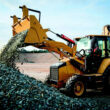The foundation can be of plain concrete or reinforced concrete, sometimes foundation is of earth or rock like in roads, embankment and dams.
Raft Foundation
The word foundation is taken as the base of everything, the mind directly shifts towards the importance, safety related words that are associated in a must-to-have manner. Similarly in Civil Engineering and in structures foundation is the supporting base of a structure which forms the interface across which loads are transmitted to the underlying soil or rock.
Shallow Foundations are sometimes called spread foundations and include isolated pads, strip footings and raft. The most usual definition of a shallow foundation refers to the founding depth being less than the breadth. For the most part in the case of pad foundation and strip footings this is acceptable, but for wide rafts it is clearly unacceptable. It is sensible, therefore to limit the term ‘shallow’ to mean less than 3 m or less than the breadth of the footing.
Raft foundation, sometimes also referred as mat foundation is a combined footing covering the entire area underneath the structure and thus providing supports to all the walls and the columns above. The raft or mat foundation can either be placed directly on the soil or rock, but can also be placed directly on the piles if the underneath soil is that much weak.
Although, it is quite impossible to lay down hard and fast rule to define situations where a raft foundation is required. It is actually the decision of the geotechnical engineer and designer based on his judgment, keeping in view the site situation, cost, safety and ease of construction. There can always be differences of opinion about the solution therefore it is the experience and the testing that can lead you to a favorable, optimum and economical solution.
The following situations could help you in making decision of requirement for a raft foundation :-
1. If the underneath soil has low bearing pressure or the loads superimposed by the building or structure are very heavy such that the individual area needed for allowable pressure is larger sometimes more than 50 % of the total area than in such cases raft foundation.
a. Using raft foundation will increase the width and thus the ultimate bearing capacity will increase, because increasing width will bring deeper soil layers in action.
b. Increasing the depth of action of the foundation would decrease the settlement.
c. As raft foundation bridges over cavities in the underneath soil, it diminishes the chances of differential settlement. A structure is always designed in a way to bear a safe differential settlement but above that critical dangerous stresses would develop that would not be bearable for the structure. Thus raft foundation ensures equal settlement and thus increases the bearable settlement than that if the foundation is build on individual footings.
It must be mentioned here that you can not always expect the deeper layer of soils to be of great bearing quality and capacity, reverse can also occur. In such situations it will be advantageous to provide individual footings so that the zone of influence of the footings remains within the top stronger layer.
2. Sometimes it is decided by the designers that if more than 50% of the area of the structure will be occupied by individual footings than in such cases it is necessary to provide an overall raft. But this is not always true, the quantity of reinforcement steel and concrete required to avoid excessive deflections and cracking of raft carrying unequal column loads, may be larger and may make raft foundation uneconomical. In such situations it is more economical to excavate the entire site to a level formation, construct individual closed space footings (sometimes touching each other) and then backfill around them. In these cases, however, one must weigh formwork costs against the extra footing material required by use of mat foundation.
3. Situations exist in practice when a soil stratum contains compressible lenses or the soil have a formation where individual layers of soil are neither parallel nor can be reasonably stratified into different layers of known properties to enable calculations of settlement to a reasonable accuracy. In such situations, individual footing, if provided, would undergo widely varying settlements which cannot be tolerated by the structure.
4. Raft foundation is unavoidable in cases where structures and equipments to be supported are very sensitive to differential settlement. Where structures naturally lend themselves for the use of raft foundation such as silos, chimneys, water towers etc.
5. You must have heard about floating foundations, apparently you may have got picture of a foundation floating on the surface of water or air; however, this is not the floating foundation. Sometimes we may encounter a soil that is very compressible and soft as well, such that buildings cannot be founded on them. In such cases a solution exists, how if we remove the equal quantity of soil, in terms of weight, to that of the load to be supported on the soil and thus there would be no change in the stress. Such a foundation is called floating foundation.
However, in practice it is rarely possible to balance the loading so that no additional pressure comes on the soil. However, in such cases still, it is only a part of the total load which comes on the bottom soil and, thus it is possible to construct a building inducing a much larger load than the soil would have otherwise supported.
After said that, we know that soil if was under excess loading is suddenly released than it swell and come up thus in such cases reconsolidation of the soil must be considered a necessary step to be taken to prevent detrimental effects.
6. Basements located below ground water table should use a mat as their base to provide water tight construction. The alternative of having individual columns footings connected by thin slabs has not proved to be successful in most of the cases; presents difficulties in water proofing, causes concentration of stresses at the junction of the thin slabs and footings and also at the junction of the basement walls and raft causing cracks to develop. This arrangement, therefore, should not be resorted to unless the economy is of such a magnitude as to outweigh all other considerations.
Even in cases where sub-soil water Level is low and basement does not extend below ground water table, long-term built-up of surface water accumulating against basement walls and bottom should be allowed for. This is particularly so in case of impermeable soils or of large surface areas draining towards the building like areas on sloping ground near hillrocks. The basement walls should be also normally be designed as self-supporting cantilever retaining walls even though they may eventually be strutted by floor construction. It is convenient and often impossible to provide temporary raking struts to support a basement retaining wall until time as strutting given by ground floor or intermediate floor is completed.
7. Situations also arise when isolated footings are subjected to very large eccentric loadings, and one is faced with the possibility of excessive footing rotation, excessive differential settlement or possibility of exceeding the allowable bearing capacity of the soil at some location. This can happen when the building consists of shear walls and columns, shear walls sharing most of the horizontal load subjecting its footings to large settlements and rotation, decreasing the effectiveness of the shear walls and also creating difficulties by way of large differential settlements raft, if provided, will even out these deformations.
















